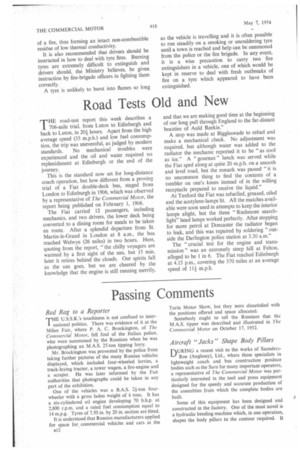Rare But Dangerous
Page 37

Page 38

If you've noticed an error in this article please click here to report it so we can fix it.
ALTHOUGH tyre fires are rare, their results can be disastrous. It is, therefore, essential that operators and drivers, particularly of heavy goods and passenger vehicles, should understand their causes, prevention and treatment.
In all the recorded cases concerning buses and coaches in this country, the inner tyre of twins has caught fire. Most of the tyre fires on heavy goods vehicles have also originated in twin equipment. The outbreak normally occurs shortly after the vehicle comes to rest.
One of the causes appears to be prolonged running with an undetected puncture or with a seriously underinflated tyre. As a simple precaution, the use of old or damaged inner tubes should be avoided, Pressures should be checked regularly and at stages on long journeys.' Treads should be inspected at least once a week and anything that is likely to inflict damage should be removed.
Another common cause is brake-drum overheating, which explains why it is normally the inner member of twin equipment that catches fire. Overheating of brake drums can result in the baking and decomposition of the inner tube and flap or of the beads of the cover. When either of these occurs, the tyre deflates and its fellow has to carry a double load_ Spontaneous Ignition The driver may well be unaware of the event and may drive for miles with the deflated tyre whipping about on the wheel and chafing against the other tyre, the rim or the chassis, whilst the overloaded tyre may soon become too hot. Rubber dust is produced by the chafed tyre in the hot and restricted space of the wheel-arch and, in the experience of the Ministry of Transport, it is possible under such conditions for ignition to take place spontaneously at probably 2500-3O0 C.
The need for the correct adjustment of brakes to avoid binding therefore needs no emphasis. In some known cases of tyre fires, repeated reports of binding had been made and in certain others the drivers continued to run their vehicles although they were aware that the brakes were rubbing.
Bad maintenance is not, however, the sole cause of brake-drum overheating. Inadequate clearance between drums and wheel rims may result in serious trouble with brake facings and tyres. In this matter the operator is entirely in the hands of the manufacturer.
Some makers are now reducing drum diameter to afford greater air space. The. problem of overheating would be much relievedby using inboard drums or disc brakes, or by fitting single rear tyres so that the drums were open to the air. With single tyres, too, the driver would have immediate warning of a puncture.
Some British operators who carry inflammable loads are now following the Continental practice of fitting permanent visible pressure gauges to inner twin wheels. These devices can be connected to an audible signal in the cab.
Buses Completely Destroyed During the past year or so several coaches and buses have quickly been destroyed by fire originating in a tyre. It appears that in those cases the rubber covering the steel wheel-arch was distilled by the heat conducted through the wheel-arch from the burning tyre. It is thought that inflammable vapours were given off and filled the saloon, and were probably ignited by flames, the heat of which shattered the glass of one of the windows. When the vapour was ignited, all the combustible material in the coach caught fire almost simultaneously.
This theory has been substantiated by experiments conducted by the Ministry. A fire was started under the off-side wheel-arch of a test vehicle and in 11 minutes a temperature of 610° C. was reached. Rubber matting on the wheel-arches vaporized and spontaneous ignition occurred.
As a result, the Ministry has recommended that the use of rubber matting or other combustible material on wheel-arches should be discontinued. Instead, they should be covered with a material which' could not give off an inflammable vapour under heat and would remain in. place in the event of a fire, thus forming an intact non-combustible residue of low thermal conductivity.
It is also recommended that drivers should be instructed in how to deal with tyre fires. Burning tyres are extremely difficult to extinguish and drivers should, the Ministry believes, be given instruction by fire-brigade officers in fighting them correctly.
A tyre is unlikely to burst into flames so long as the vehicle is travelling and it is often possible to run steadily on a smoking or smouldering tyre until a town is reached and help can be summoned from the police or the fire brigade. In any event, it is a wise precaution to carry two fire extinguishers in a vehicle, one of which would be kept in reserve to deal with fresh outbreaks of fire on a tyre which appeared to have been extinguished.








































































































